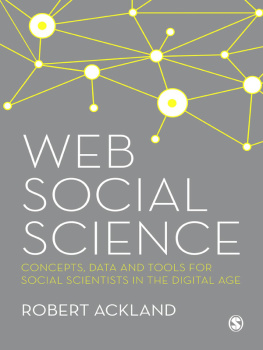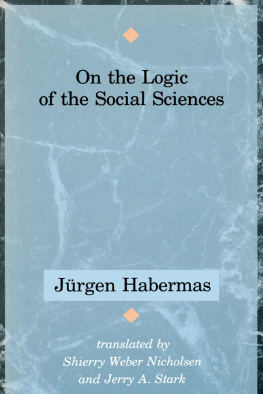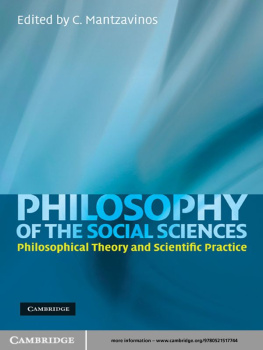Copyright 2021 by Princeton University Press
Princeton University Press is committed to the protection of copyright and the intellectual property our authors entrust to us. Copyright promotes the progress and integrity of knowledge. Thank you for supporting free speech and the global exchange of ideas by purchasing an authorized edition of this book. If you wish to reproduce or distribute any part of it in any form, please obtain permission.
Requests for permission to reproduce material from this work should be sent to
Published by Princeton University Press
41 William Street, Princeton, New Jersey 08540
6 Oxford Street, Woodstock, Oxfordshire OX20 1TR
press.princeton.edu
All Rights Reserved
Library of Congress Cataloging-in-Publication Data
Names: Mahoney, James, 1968 author.
Title: The logic of social science / James Mahoney, Princeton University Press.
Description: Princeton, New Jersey : Princeton University Press, [2021] | Includes bibliographical references and index.
Identifiers: LCCN 2020049205 (print) | LCCN 2020049206 (ebook) | ISBN 9780691217055 (hardback) | ISBN 9780691214955 (paperback) | ISBN 9780691214993 (ebook)
Subjects: LCSH: Social sciencesResearch. | Social sciencesMethodology.
Classification: LCC H62 .M23578 2021 (print) | LCC H62 (ebook) | DDC 300.1dc23
LC record available at https://lccn.loc.gov/2020049205
LC ebook record available at https://lccn.loc.gov/2020049206
Version 1.0
British Library Cataloging-in-Publication Data is available
Editorial: Bridget Flannery-McCoy and Alena Chekanov
Production Editorial: Natalie Baan
Cover Design: Wanda Espaa
Production: Erin Suydam
Publicity: Kate Hensley
Cover art by Fernand Lger, Mechanical Elements, 1924. Oil on canvas, 91.4 x 66 cm (36 x 26 in.) 2021 Artists Rights Society (ARS), New York / ADAGP, Paris. Photo: Yale University Art Gallery, Charles B. Benenson, B.A. 1933, Collection
ILLUSTRATIONS
Tables
.Natural Kinds, Human Kinds, and Partial Natural Kinds
.Competing Orientations for the Social Sciences
.Three Models of Causality
.Implications of Set-Theoretic Tests for Propositions
.Types of Counterfactual Statements in Case-Study Research
.Inventory of Results from Set-Theoretic Sequence Analysis
.A Stylized Typology of Theory Frames
.Examples of Critical Events in Case-Study Research
.Typology of Path-Dependent Frameworks of Institutional Reproduction
Figures
.Ogden and Richards Semantic Triangle
.Conceptual Spaces and the Category of a Lie
.Illustration of Spatial Set
.Illustration of Sequenced Constitutive Sets
.A Set-Theoretic Typology of Worlds I
.A Set-Theoretic Typology of Worlds II
.A Part-Whole Hierarchy: Worlds, Cases, and Observations
.A Set-Theoretic Hierarchy: Worlds, Cases, and Observations
.Set-Theoretic Conceptualization of a Necessary Condition
.Set-Theoretic Conceptualization of a Sufficient Condition
.Set-Theoretic Conceptualization of a Necessary and Sufficient Condition
.Set-Theoretic Conceptualization of INUS Conditions
.Set-Theoretic Conceptualization of SUIN Conditions
.Illustration of the Classic Mode of Category Definition
.Venn Diagram of Defining Conditions of Democracy: Central America, 19812000
.Illustration of the Family Resemblance Mode of Category Definition
.Illustration of Continuous-Set Membership
.Illustration of Continuous-Set Aggregation: El Salvador in 1986
.Membership Values with a Necessary Cause
.Membership Values with a Sufficient Cause
.Location of Cases for Necessary Condition and Sufficient Condition with Continuous-Set Scatterplot
.Illustration of Increasing Importance with Continuous-Set Scatterplot
.Continuous-Set Scatterplot of a Necessary Condition for 15 Latin American Cases
.Set Diagram Derived from Continuous-Set Scatterplot
.The Logic of a Necessity Test
.The Logic of a Sufficiency Test
.A Non-Deterministic Necessity Test (90% Necessary)
.A Non-Deterministic Sufficiency Test (90% Sufficient)
.Illustration of a Necessary Condition Counterfactual
.Necessary Condition Counterfactual versus SUIN Condition Counterfactual
.Small Events and Plausible Counterfactuals
.Outcome Specificity and Trivialness
.Stylized Summary of Brooks and Wohlforths Argument (2007a, 2007b)
.Stylized Summary of Englishs Argument (2007)
.Cause Specificity and Trivialness
.Relationship of Level of Generality and Causal Importance
.Relationship of the Specificity of Events to the Importance and Plausibility of Counterfactual Propositions
.Stylized Summary of Harveys Counterfactual Argument (2012)
.Backward Projection with a Miracle Counterfactual
.Set-Theoretic Illustration of Contextualization
.Set-Theoretic Illustration of Diminishment
.Set Diagram Illustrating Possible Worlds Approach
.Set Diagram Illustrating Belief Updating through Possibility Elimination
.Illustration of Meteorite-Collision Theory of the Extinction of Dinosaurs
.Consequentialness and Expectedness
.Types of Set-Membership Observations
.Illustration of Accumulation of Evidence in Favor of a Hypothesis
.Illustration of an Approximate Necessity Test
.Illustration of an Approximate Sufficiency Test
.Set-Theoretic Tests Revisited
.Dominant Relationships for Basic Theory Frames
.Illustration of Force Dynamic Patterns
.Theory Frames and Disciplines in the Social Sciences
.Normative Traditions and Specialized Orientations
.Normative Traditions and Disciplines in the Social Sciences
.Typology of Institutional Change
.Typology of Causal Effects
.Illustration of Necessity Effects
.Illustration of Sufficiency Effects
.Illustration of the Rule of Causal Contingency
.Self-Reinforcing Sequence: Necessity Bonds
.Self-Reinforcing Sequence: Sufficiency Bonds
.Goldstones (1998b) Explanation of the Industrial Revolution in England








